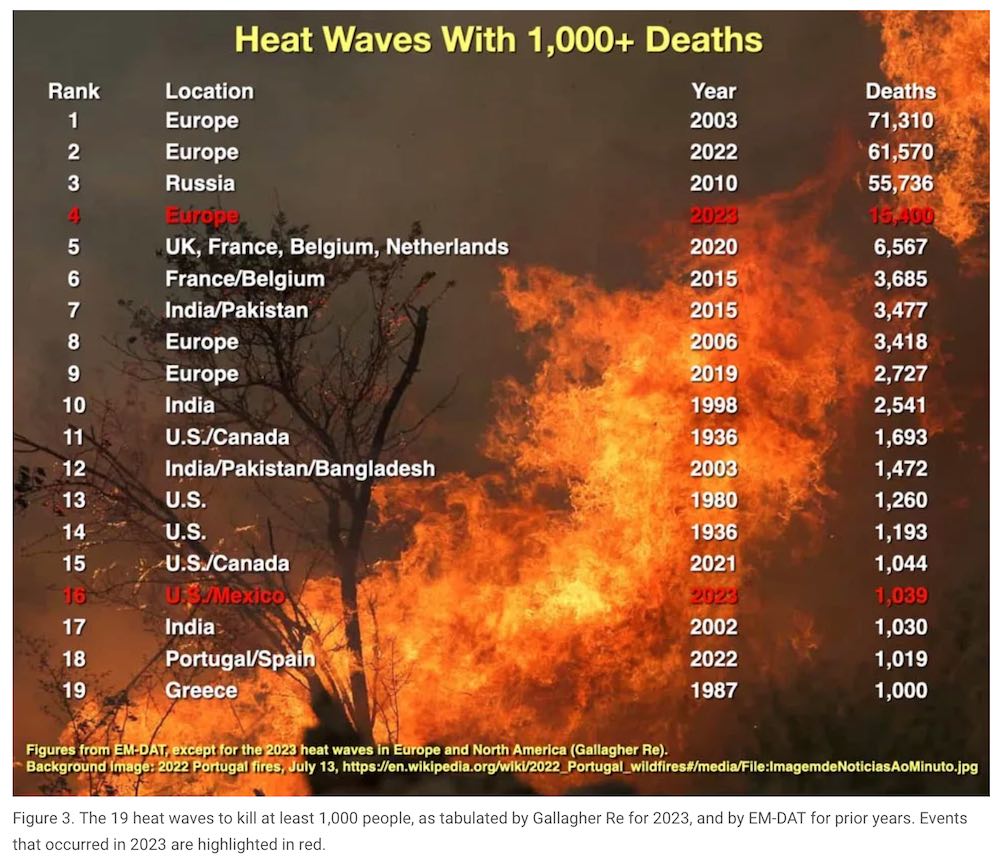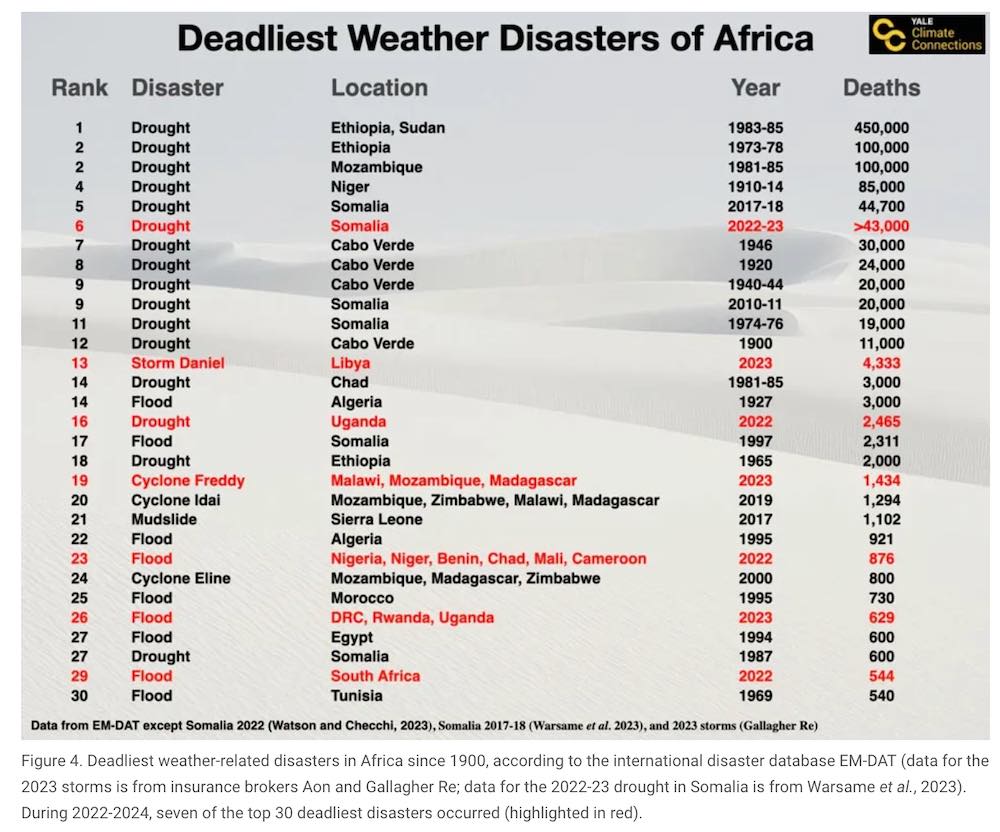The planet was besieged by a record 63 billion-dollar weather disasters in 2023, surpassing the previous record of 57 set in 2020, said insurance broker Gallagher Re in its annual report issued January 17.
The total damage wrought by weather disasters in 2023 was $301 billion, with an unusually high 57% of that total being insured damages. For comparison, weather disasters did $360 billion in damage in 2022, with 39% of the total being insured damages. Gallagher Re’s historical database extends back to 1990.
Inflation and development are among the factors producing this rise, but the Gallagher Re report stresses that human-produced climate change is also a culprit.
“We continue to witness the ongoing influence of climate change on the behavior of individual events and broader weather patterns,” noted the report, and, “the fingerprints are now regularly evident.”
The report concluded, “If we do not meaningfully change the status quo and subsequently reverse the growth of carbon dioxide emissions, then we should no longer be surprised at the consequences of more extreme weather/climate events that are influenced by warmer ocean waters and a destabilized atmosphere.”


US sets a record for billion-dollar weather disasters, with 28
As discussed in our January 9 post, the U.S. set an all-time record for billion-dollar weather disasters in 2023, with 28, according to NOAA; Gallagher Re tallied 31 U.S. billion-dollar weather disasters. The total cost of 2023’s billion-dollar weather disasters, $92.9 billion, was the ninth-highest on record in the NOAA database. The list included 19 severe storm events, two tropical cyclones, four floods, one winter weather event, one drought, and one wildfire event. The cost of the 19 severe storm events in 2023 was $54 billion, setting a new record for the costliest year on record for that peril (previous record: $44 billion in 2011).
Hail the big driver of severe thunderstorm losses
The Gallagher Re report estimated that severe thunderstorm damages have been increasing at 9.6% per year since 2000, and have largely been driven by “expansion of suburban and exurban population areas that increase the potential of incurred damage.” Hail causes 50-80% of insured damage from severe thunderstorms.

Deadliest weather disaster of 2023: the European heat wave
The deadliest disaster of 2023 was the summer heat wave in Europe, which killed over 15,400 people. This ranks as the fourth-deadliest heat wave on record globally, using historical statistics from EM-DAT, the international disaster database (Figure 3). In addition, a heat wave that struck the U.S. and Mexico in 2023 was blamed for 1,039 deaths.
Deadliest storm of 2023 and costliest disaster in African history: Storm Daniel in Libya
The deadliest storm of 2023 was Storm Daniel, which killed at least 4,333 people in Libya, after heavy rains caused two dams to fail upstream of the coastal city of Derna, according to the WHO. At least 8,500 people remain missing in Libya. Daniel is also being blamed for 28 deaths in Greece, and the total death toll of 4,361 makes Daniel the deadliest storm globally since 2013 when Super Typhoon Haiyan killed 7,354 people in the Philippines.
Daniel’s Libya death toll surpasses the 1927 floods in Algeria (3,000 killed) as the deadliest storm in Africa in data going back to 1900, according to statistics from EM-DAT. A rapid analysis of Daniel’s impact on Libya found that the extreme rainfall was made up to 50 times more likely and 50% more intense by climate change.
Daniel’s $7 billion in damage in Libya makes it Africa’s costliest weather disaster on record, using statistics from EM-DAT. That database lists the two costliest African weather disasters as being two 2022 floods: a $4.2 billion flood in Nigeria and a $3.5 billion flood in South Africa.
Deadliest tropical cyclone on record for Africa: Cyclone Freddy
Cyclone Freddy killed 1,434 people during its record-long 35-day trek over the South Indian Ocean in February and March 2023. Freddy was the deadliest tropical cyclone on record for Africa, surpassing Cyclone Idai of 2019 (1,294 killed). Freddy left 679 dead and 537 people missing and presumed dead in Malawi, with additional fatalities in Madagascar (17), Mozambique (198), Zimbabwe (2), and Mauritius (1). Freddy is now the second-deadliest tropical cyclone in the entire Southern Hemisphere behind an unnamed 1973 cyclone in Indonesia that killed 1,650.
Climate change is increasing the severity of deadly African weather disasters
Despite recent improved weather forecasting technology and increased disaster awareness and preparation efforts, Africa has suffered an unprecedented number of deadly weather-related disasters over the past two years. Storm Daniel in Libya is the seventh weather-related disaster to kill at least 500 Africans since 2022; an astonishing 23% of the continent’s 30 deadliest weather-related disasters since 1900 have occurred in the past two years (Figure 4). This ominous figure could well be a harbinger of the future, as higher vulnerability, a growing population, and more extreme weather events from climate change cause an increase in deadly disasters, even without accounting for the recurring episodes of catastrophic regional drought that can take tens of thousands of African lives in a single year (see Figure 4 below). For more detail, see our September 13 post on Storm Daniel, The Libya floods: a climate and infrastructure catastrophe.

Most expensive typhoon on record for China: Doksuri
After causing $300 million in damage to the Philippines and Taiwan, Category 4 Typhoon Doksuri, the strongest on record to hit China’s Fujian province, made landfall there July 28. According to Gallagher Re, the damage in China from Doksuri and its remnants was $18.2 billion, making it the costliest typhoon in Chinese history (previous record: $11.9 billion, Typhoon Lekima, 2019). According to EM-DAT, the only costlier typhoon on record in the entire Northwest Pacific was Typhoon Mireille of 1991, which caused $21 billion in damage to Japan (in inflation-adjusted dollars).
Doksuri killed at least 111 people in China and the Philippines. The remnants of the typhoon dumped 744.8 mm (29.32 inches) of rainfall in Beijing over five days, setting an all-time precipitation record for the capital region since record-keeping began during the Qing dynasty in 1883. It’s also quite a bit more than Beijing typically experiences in an entire year: The city’s annual average from 1991 to 2020 was 20.78 inches.
The most expensive typhoons to hit China (in dollars adjusted for inflation):
- $18.2 billion, Doksuri, 2023
- $11.9 billion, Lekima, 2019
- $8.7 billion, Fitow, 2013
- $6.5 billion, Rumbia, 2018
- $5.4 billion, Rammasun, 2014
- $5.4 billion, Mujigae, 2015
This list leaves out what was possibly the most destructive Chinese typhoon of all time, Typhoon Nina of 1975. Nina stalled out and dumped prodigious rains for two days in the Ru River drainage basin upstream of the Banqiao Dam, leading to its collapse and the loss of 171,000 lives, with an area 34 miles long and eight miles wide wiped out.
Seven nations had their costliest weather disasters on record in 2023
Based on the 2023 numbers from Gallagher Re, at least seven nations set all-time records for their most costly weather-related disaster during 2023, using inflation-adjusted numbers from EM-DAT (EM-DAT has not yet released its 2023 numbers). For comparison, four nations had their most expensive weather-related natural disaster in 2022, two in 2021, one in 2020, seven in 2019, two in 2018, three in 2017, four in 2016, and nine in 2015. Note that these tallies will be considerably different depending upon the database used; Gallagher Re disaster figures can differ from EM-DAT’s by a factor of two or more. Here are the seven nations that had their costliest weather disaster in 2023:
Mexico: $15.1 billion, Hurricane Otis (previous record: $7.5 billion, 2005’s Hurricane Wilma )
Argentina: $9.2 billion, drought (previous record: $4 billion, 2018 drought)
Spain: $8.2 billion, drought (previous record: $3.1 billion, 2005 wildfires)
Libya: $7 billion, Storm Daniel (previous record: $8 million, 2019 floods)
New Zealand: $3.8 billion, Cyclone Gabrielle (previous record: $3 billion, 2023 North Island flood)
Greece: $3 billion, Storm Daniel (previous record: $2.5 billion, 2007 wildfires)
Uruguay: $1.3 billion, drought (previous record: $0.6 billion, 2018 drought)
Bob Henson contributed to this post.
This article was originally published by Yale Climate Connections. Republished here under a Creative Commons: Attribution-Noncommercial-No Derivative Works licence. Read the original article here.








